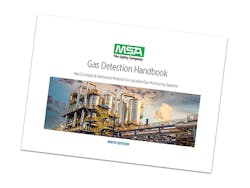MSA Safety Releases Gas Detection Handbook
The handbook offers a comparison of today’s most widely used gas detection technologies, which can help readers better understand the advantages of the various gas sensing technologies in multiple plant environments. Understanding these different technologies is essential to making good decisions that help protect people, equipment, plants and surrounding communities, according to MSA Safety. In addition, recognizing how gas detection technologies perform in different environments, such as wind, high temperatures, low temperatures and humidity, helps optimize sensor selection for maximum effectiveness, extended life and reduced maintenance.
The handbook also includes a table indicating the gas hazards common to specific applications within major industries including chemical, oil/gas, power generation, food/beverage, pharmaceutical and water/waste treatment. In addition, the handbook’s summary of key gas detection instrumentation approvals information, including hazardous locations classification, is valuable to comply with safety standards and regulations.
MSA’s exclusive sensor placement guide provides important factors to take into consideration when determining optimum gas sensor placement. Understanding sensor placement is critical to effective gas leak monitoring and helps avoid failures to alarm during actual gas leaks as well as avoiding false alarms that cause unnecessary plant shutdowns, according to MSA Safety. The section on combustible atmospheres explains the basic conditions under which a flame can appear, including the source of the fuel gas, the oxygen level required to burn and the heat source of ignition. Examples of combustible gas heat and ignition sources are provided such as burners, welding torches and sparks from electrical switching. The handbook explains the difference between oxygen deficient areas which contain too little oxygen (less than 19.5% oxygen by volume) that affects breathing and oxygen enrichment (more than 25% oxygen by volume) that result in an increased risk of explosion.
For more information, visit: www.msasafety.com
